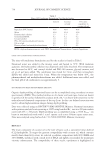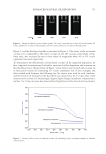Halftones: Common examples are color or grayscale figures containing pictures only, with no text or thin lines. The suggested minimum resolution for this type of image is 300 ppi at publication size. Raster images should be supplied in TIF format. PDF and JPG are also acceptable. Vector Images: Vector images are typically generated using drawing or illustration programs (e.g., Adobe Illustrator) and are composed of mathematically defined geometric shapes—lines, objects, and fills. Vector graphics are resolution independent and can be enlarged to any size without quality loss. Vector images should be supplied in EPS format, with all fonts embedded or converted to outlines, and graph lines at least 0.25 points thick. PDF is also acceptable. Authors who do not comply with these guidelines will be asked to resubmit their figures in a print- quality format, which may delay publication. 9. References: References should be numbered in the order in which they appear in the text and should be listed in numerical order at the end of the article under "References". Citations in the text should be on line and parenthesized, e.g., (6) or (11-13). The references to journal articles must appear in the following form: (a) The initials and surname of each author. (b) The full title of the paper (first word capitalized). (c) The name of the journal in italics. Use standard abbreviations as in Chemical Abstracts. (d) The volume number in bold face type. (e) The first and last pages of the article separated by a hyphen. (f) Year of publication of the article (in parentheses) the month must be included for journals that do not use continuous pagination. The following is an example of a correctly prepared journal reference note all spacing and punctuation: 1) L. E. Gaul and G. B. Underwood, Relation of dew point and barometric pressure to chapping of normal skin,). J. Invest Dermatol, 19, 9-19 (1952). Book references are handled similarly and should include pertinent page numbers: 1) S. Rothman, Physiology and Biochemistry of the Skin (The University of Chicago Press,Chicago, 1954), pp. 494-560. References to books containing contributions from authors appear as follows: 1) S. D. Gershon, M. A. Goldberg, and M. M. Rieger, "Permanent Waving," in Cosmetics, Science and Technology, 2nd ed., M. S. Balsam and E. Sagarin. Eds. (Wiley Interscience, New York, 1972), Vol. 2, pp. 167-250. 10. Claims of Priority/Primacy: The JOURNAL OF COSMETIC SCIENCE does not allow claims of priority or primacy therefore, terms such as “new”/“novel”/“first” should not be included in the title or body of the paper. AFTER SUBMISSION OF PAPERS
Rejection of Papers Submitted: Papers not prepared in accordance with these directions or deemed to be outside the scope of articles published in the JOURNAL will be returned to the author by the Editor. After the paper has been reviewed by the editor and reviewers, the senior author will be sent any comments that need to be addressed. If necessary, the senior author must submit a revised paper which will be reviewed by the Editor prior to being approved for publication. If the revised paper is still not acceptable, the Editor may reject for publication. Page Proofs: After an author's paper is accepted and before final publication, page proofs will be emailed to the senior author for careful review and correction. Proofs should be verified against the paper and any alterations annotated in the PDF. The Publication Committee does not accept this responsibility. Alterations in an article after it has been typeset will be made at the author's expense, and the author will be billed for such changes. Corrected page proofs must be returned within 10 days to the Journal office. Offprints and Reprints: The senior author of each paper will automatically receive a PDF copy of the final version of their manuscript on the issue’s publication date. The author will also receive 2 months complimentary access to the Journal of Cosmetic Science recent issues online. Charges: There are no page charges. Any material set into type but ordered deleted from publication at the page proof stage must also be paid for by the author. These charges will be invoiced to the senior author at the time of publication.
Purchased for the exclusive use of nofirst nolast (unknown) From: SCC Media Library & Resource Center (library.scconline.org)






































































































































